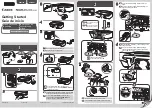
2-1
Confidential
CHAPTER 2 TROUBLESHOOTING
1.
INTRODUCTION
Troubleshooting is the countermeasure procedures that the service personnel should follow
if an error or malfunction occurs with the printer. It is impossible to anticipate all of the
possible troubles which may occur in future and determine the troubleshooting procedures,
so this chapter covers some sample troubles. However, those samples will help the service
personnel pinpoint and repair other defective elements.
1.1
Precautions
Be sure to observe and follow all the precautions to prevent any secondary problems from
happening during troubleshooting.
(1) Always turn off the power and unplug the power cable before removing any covers or
PCBs, adjusting the printer and so on. If you need to take voltage measurements with
the power switched on, take the greatest of care not to receive an electric shock.
(2) When connecting or disconnecting cable connectors, make sure that you hold the
connector body and not the cables.
(3) Static electricity charged in your body may damage electronic parts.
Before handling the PCBs, touch a metal portion of the printer to discharge static
electricity charged in your body. When transporting PCBs, be sure to wrap them in
conductive sheets.
When replacing the PCBs, put on a grounding wrist band and perform the job on a static
mat. Also take care not to touch the conductor sections on the flat cables.
(4) Follow the warning by all means.
(5) Verify again that the repaired portion works properly.
The fuser unit becomes extremely hot during operation. Wait until it has cooled down
sufficiently before replacing consumable items. DO NOT remove or damage the
caution label located on or around the fuser.
WARNING
DO NOT use flammable substances such as alcohol, benzine, thinner or any type of
spray to clean the inside or outside of the printer. Doing this may cause a fire or
electrical shock.
















































